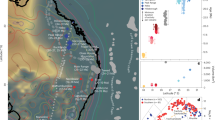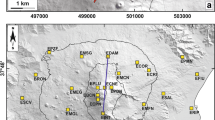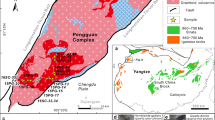Abstract
Andesitic volcanic rocks are common in subduction zones and are argued to play an important role in the formation and evolution of the continental crust at convergent margins1,2,3,4. Andesite formation is dominated by mixing between iron- and magnesium-rich (mafic) magmas and silica-rich (felsic) magmas1,2,4. The abundance of andesites in many subduction zones suggests they erupt in preference to the magmas that mix to produce them4; however, the reasons for this remain unclear. Here we use textural and geochemical analyses of andesites from Mount Hood, Oregon, to show that eruptions are closely linked with episodes of mafic recharge—the intrusion of mafic magma into a shallow felsic magma reservoir. The felsic and mafic magmas involved rarely erupt by themselves, probably because the former are too viscous and the latter too dense. Mafic recharge overcomes these barriers to eruption, and, as it also promotes efficient mixing, results in preferential eruption of mixed andesitic magmas. The abundance of andesites therefore relates to local crustal conditions and the ability of magmas to erupt. We suggest that volcanoes, such as Mount Hood, that erupt homogeneous andesitic compositions through time are those that are the most reliant on mafic recharge to initiate eruptions.
This is a preview of subscription content, access via your institution
Access options
Subscribe to this journal
Receive 12 print issues and online access
$259.00 per year
only $21.58 per issue
Buy this article
- Purchase on Springer Link
- Instant access to full article PDF
Prices may be subject to local taxes which are calculated during checkout




Similar content being viewed by others
References
Anderson, A. T. Magma mixing: Petrological process and volcanological tool. J. Volcanol. Geotherm. Res. 1, 3–33 (1976).
Eichelberger, J. C. Andesitic volcanism and crustal evolution. Nature 275, 21–27 (1978).
Rudnick, R. L. Making continental-crust. Nature 378, 571–578 (1995).
Reubi, O. & Blundy, J. A dearth of intermediate melts at subduction zone volcanoes and the petrogenesis of arc andesites. Nature 461, 1269–1273 (2009).
Marsh, B. D. On the crystallinity, probability of occurrence, and rheology of lava and magma. Contrib. Mineral. Petrol. 78, 85–98 (1981).
Eichelberger, J. C., Izbekov, P. E. & Browne, B. L. Bulk chemical trends at arc volcanoes are not liquid lines of descent. Lithos 87, 135–154 (2006).
Scott, W. E. et al. Geologic History of Mount Hood Volcano, Oregon: A Field-Trip Guidebook 1–38 (US Geol. Surv. Open File Rep., Vol. 97(263), 1997).
Cribb, J. W. & Barton, M. Significance of crustal and source region processes on the evolution of compositionally similar calc-alkaline lavas, Mt Hood, Oregon. J. Volcanol. Geotherm. Res. 76, 229–249 (1997).
Darr, C. M. Magma Chamber Processes Over the Past 475,000 Years at Mount Hood, Oregon: Insights From Crystal Zoning and Crystal Size Distribution Studies. M.S. thesis, Oregon State Univ. (2006).
Woods, M. M. Compositional and Mineralogical Relationships Between Mafic Inclusions and Host Lavas as Key to Andesite Petrogenesis at Mount Hood Volcano, Oregon. M.S. thesis, Portland State Univ. (2004).
Higgins, M. D. & Roberge, J. Three magmatic components in the 1973 eruption of Eldfell volcano, Iceland: Evidence from plagioclase crystal size distribution (CSD) and geochemistry. J. Volcanol. Geotherm. Res. 161, 247–260 (2007).
Salisbury, M. J., Bohrson, W. A., Clynne, M. A., Ramos, F. C. & Hoskin, P. Origin of the 1915 Lassen Peak eruption by magma mixing: Evidence for formation of chemically distinct plagioclase populations from crystal size distributions and in situ chemical data. J. Petrol. 49, 1755–1780 (2008).
Sparks, S. R. J., Sigurdsson, H. & Wilson, L. Magma mixing—mechanism for triggering acid explosive eruptions. Nature 267, 315–318 (1977).
Eichelberger, J. C. Vesiculation of mafic magma during replenishment of silicic magma reservoirs. Nature 288, 446–450 (1980).
Murphy, M. D. et al. The role of magma mixing in triggering the current eruption at the Soufriere Hills volcano, Montserrat, West Indies. Geophys. Res. Lett. 25, 3433–3436 (1998).
Watts, R. B., de Silva, S. L., de Rios, G. J. & Croudace, I. Effusive eruption of viscous silicic magma triggered and driven by recharge: A case study of the Cerro Chascon-Runtu Jarita Dome Complex in Southwest Bolivia. Bull. Volcanol. 61, 241–264 (1999).
Sparks, R. S. J. & Marshall, L. A. Thermal and mechanical constraints on mixing between mafic and silicic magmas. J. Volcanol. Geotherm. Res. 29, 99–124 (1986).
Pinel, V. & Jaupart, C. The effect of edifice load on magma ascent beneath a volcano. Phil. Trans. R. Soc. Edinburgh 358, 1515–1532 (2000).
Martel, C., Ali, A. R., Poussineau, S., Gourgaud, A. & Pichavant, M. Basalt-inherited microlites in silicic magmas: Evidence from Mount Pelee (Martinique, French West Indies). Geology 34, 905–908 (2006).
Browne, B. L. et al. Magma mingling as indicated by texture and Sr/Ba ratios of plagioclase phenocrysts from Unzen volcano, SW Japan. J. Volcanol. Geotherm. Res. 154, 103–116 (2006).
Halama, R. et al. Pre-eruptive crystallization conditions of mafic and silicic magmas at the Plat Pays volcanic complex, Dominica (Lesser Antilles). J. Volcanol. Geotherm. Res. 153, 200–220 (2006).
Clynne, M. A. et al. in A Volcano Rekindled; the Renewed Eruption of Mount St. Helens, 2004–2006. Vol. 1750 (eds Sherrod, D. R., Scott, W. E. &Stauffer, P. H.) (US Geological Survey Professional Paper, 2008).
Pallister, J. S., Hoblitt, R. P., Crandell, D. R. & Mullineaux, D. R. Mount St. Helens a decade after the 1980 eruptions: Magmatic models, chemical cycles, and a revised hazards assessment. Bull. Volcanol. 54, 126–146 (1992).
Higgins, M. D. Measurement of crystal size distributions. Am. Mineral. 85, 1105–1116 (2000).
Costa, F., Chakraborty, S. & Dohmen, R. Diffusion coupling between trace and major elements and a model for calculation of magma residence times using plagioclase. Geochim. Cosmochim. Acta 67, 2189–2200 (2003).
Scaillet, B., Holtz, F. & Pichavant, M. Phase equilibrium constraints on the viscosity of silicic magmas 1. Volcanic–plutonic comparison. J. Geophys. Res. 103, 27257–27266 (1998).
Giordano, D., Russell, J. K. & Dingwell, D. B. Viscosity of magmatic liquids: A model. Earth Planet. Sci. Lett. 271, 123–134 (2008).
Bottinga, Y. & Weill, D. F. Densities of liquid silicate systems calculated from partial molar volumes of oxide components. Am. J. Sci. 269, 169–182 (1970).
Kent, A. J. R. et al. Vapor transfer prior to the October 2004 eruption of Mount St Helens, Washington. Geology 35, 231–234 (2007).
Lundgaard, K. L. & Tegner, C. Partitioning of ferric and ferrous iron between plagioclase and silicate melt. Contrib. Mineral. Petrol. 147, 470–483 (2004).
Acknowledgements
This research was supported by a grant from the National Science Foundation (EAR-0838421) to A.J.R.K. and K.M.C. and by a USGS Kleinman grant to A.M.K. A.J.R.K. is also grateful for extra support from the University of Aarhus. F. Tepley, A. Weinsteiger and A. Ungerer provided extra assistance with electron microprobe and laser-ablation inductively coupled plasma mass spectrometry analyses. W. Bohrson provided assistance with CSD measurements and useful discussions. Comments by F. Costa, P. Ruprecht, O. Bachmann, E. Brook, A. Meigs and D. Wildenschild improved an initial version of this manuscript. W. Scott and C. Gardner of the USGS David A. Johnston Cascade Volcano Observatory provided invaluable assistance with sample collection.
Author information
Authors and Affiliations
Contributions
C.D. provided initial data from Mount Hood as part of a MS thesis at Oregon State University. C.D. and M.J.S. carried out CSD measurements; A.J.R.K. and A.M.K. obtained mineral chemistry data. A.J.R.K., C.D., A.M.K. and K.M.C. conducted field studies and sampling. All authors provided input to discussion and A.J.R.K. took the lead on writing the manuscript.
Corresponding author
Ethics declarations
Competing interests
The authors declare no competing financial interests.
Supplementary information
Supplementary Information
Supplementary Information (PDF 666 kb)
Rights and permissions
About this article
Cite this article
Kent, A., Darr, C., Koleszar, A. et al. Preferential eruption of andesitic magmas through recharge filtering. Nature Geosci 3, 631–636 (2010). https://doi.org/10.1038/ngeo924
Received:
Accepted:
Published:
Issue Date:
DOI: https://doi.org/10.1038/ngeo924
This article is cited by
-
Pre-eruptive dynamics at the Campi Flegrei Caldera: from evidence of magma mixing to timescales estimates
Earth, Planets and Space (2023)
-
Priming and eruption of andesite magmas at Taranaki volcano recorded in plagioclase phenocrysts
Bulletin of Volcanology (2023)
-
Petrological and geochemical evidence for a hot crystallization path and a recharge filtering bypass at Antimilos, Milos volcanic field, Greece
Contributions to Mineralogy and Petrology (2023)
-
Evolution of the magma plumbing system of Miyakejima volcano with periodic recharge of basaltic magmas
Earth, Planets and Space (2022)
-
Magma hybridization and crystallization in coexisting gabbroic and granitic bodies in the mid-crust, Akechi district, central Japan
Mineralogy and Petrology (2022)



